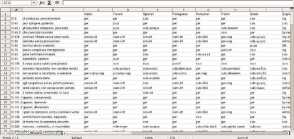2949775015
4 Mono-directional comparison Italian vs other languages
(22) The linguistic elements that translate all the Italian gerunds and “senza+INF” constructions were individuated, analysed and collected into a table in which every column is a different language and every row is an Identification number of a converb.
•* ilłl * -a J *» " a- i « V »v •• » K(S«T- O . i i«5Si a a & 9 v .

Figurę 3: The data of the comparison
The Italian gerund is quite a freąuent non-finite verb form which, however, can be substituted with a finite construction in almost every context. The gerund has a mainly adverbial function. It can be a verb modifier, a margin of the predicate (with instrumental function) and a circumstancial element (in causal, concessive or conditional relationship with the matrix clause) (Prandi 2006). Moreover the “coordinate" gerund (a kind of narrative converb) can be used to express posteriority or to add an evaluative element. The gerund meaning is largely vague and under-specilied.
The translations of the gerund consist of converbs, coordinated clauses, subordinated clauses and other not verbal elements like prepositional phrases, adverb and adjectives.
Excluding coordination, the other elements can be seen stretching on a desententialization continuum (Lehmann
1988-200) sententiality <-> nominality
' clause nonfinite construction verbal noun4
When a gerund is translated by a coordinated clause there is an explicitation on the morpho-syntactic level but as far as the coding of the relationship is concemed, the coordinated clause is not morę explicit then the gerund.
4.1 Gerund vs not verbal elements
(23) The choice of translating the gerund with a not verbal element is dispreferred in the corpus. However, in German, Danish, Czech and Slovak the number of the translations without a verb form is higher than the number of converbs. Sometimes these non verbal elements are deverbal nouns with the same meaning and arguments than the gerund they translate. Stolz et al. (2006:7) talking on comitatives notę that in one example “the translator has preferred prepositional phrases to gerunds (present active participles) because these stinks of “burocratese” in German”.
a Italian (29.32)
... e una degna meditazione mi ha indotto a riflettere, trasferendo ció che e materiale a ció che e immateriale, sulla diversita delle sacre virtu |] b German
... und eine wiirdige Meditation mich dazu bringt, durch Obertragung des Materiellen aufs Immaterielle nachzudenken iiber die Mannigfaltigkeit der heiligen Krafte ()
a Italian (2n.53)
... e riprendemmo a muoverci verso la nostra destra cercando di andare diritti di stanza in stanza. b Danish
... og vi begyndte forfra med at g&til hojre i et fors0g p&at g&den direkte vej fra rum til rum.
(24) In the next example, on the reverse, an Italian deverbal noun has been translated with converbal constructions in many languages: Spanish, Greek, Polish, Latvian, Lithuanian, Estonian, Finnish and Hungarian.
a Italian (13.93)
Prese dunąue a raccontare, eon molta prudenza nella scelta delle parole e lunghe perifrasi, di un fatto singolare [) b Spanish
Inició pues, escogiendo eon mucha prudencia las palabras y recurriendo a largas perffrasis, el relato de un acontecimiento singular |)
Wyszukiwarka
Podobne podstrony:
00081 /16b9e2d8f8d2efe7b66f1d797df498 80 Hembree & Zimmer Figurę 14. Covariance Comparisons (ac
Programmes of Study in English (or in other languages) • BA in Polish Sludies •
(g) Polis (h) Englis6 Multi-directional comparison (30) In the chapters ‘Primo Giorno, Ora Terza” (F
6 (384) Figurę 9-29 Macrotidal estuary with tidal sand bodies and dominant current directions. Compa
“It has been the effort of the author to connect the study of language with the study of other branc
BmRPWJNG Sometimes, the idea to be named already exists in other cultures by speakers of other langu
both with the direct objectives of the society and with the »higher« objectives of socialism? In oth
English for Speakers of Other LanguagesCambridge ESOL Level 3 Certificate in ESOL International* Thi
42 (209) Model 22 ok. 82 crh śr< 3vs *sSaSv .Model 22 Trochę więcej pracy czeka
“It has been the effort of the author to connect the study of language with the study of other branc
“It has been the effort of the author to connect the study of language with the study of other branc
“It has been the effort of the author to connect the study of language with the study of other branc
“It has been the effort of the author to connect the study of language with the study of other branc
angielski�8 First Certificate Language Practice Needs doing Verbs and prepositions Other problems1 U
Czy demokracja przeżyje?AFTER-TAX RATĘ OF RETURN VS. GROWTH RATĘ AT THE WORLD LEVEL, FROM ANTIQUITY
00039 ?0994c0b89c0edd69cbdfecf717cc9b 38 Molnau OPS5 (Official Production System, Version 5) is a w
więcej podobnych podstron